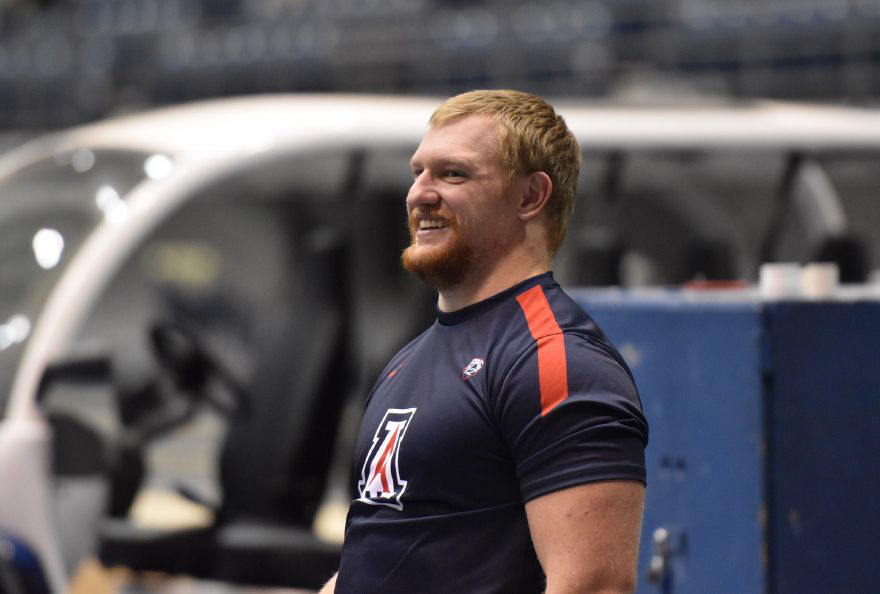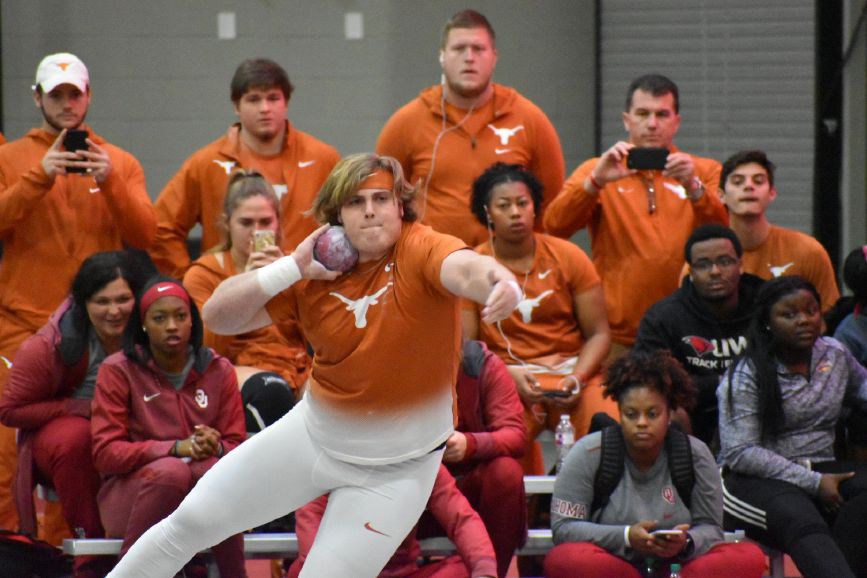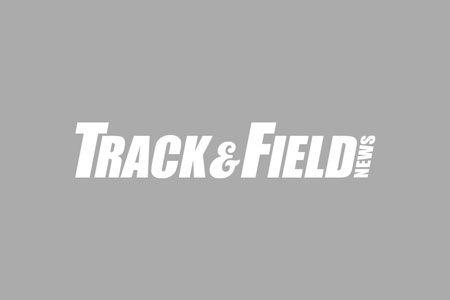by Jeff Hollobaugh
Youngsters Taking Their Shots
Jordan Geist & Tripp Piperi are opening eyes in an event where older athletes usually reign
In the world of NCAA men’s shot putting, the kids are more than alright. This year’s top frosh are threatening to upend the natural order of the event, in which yearlings aren’t usually much of a factor (see sidebar).
Two are already making headlines. Arizona’s Jordan Geist opened up indoors at 63-9¾ (19.45) and then popped a massive 70-4½ (21.45) in Seattle, becoming the youngest man ever to breach the 70-foot barrier.

At Texas, Tripp Piperi has already reached a lifetime best 65-¾ (19.83) to become the No. 7 U.S. Junior ever (Geist turns 20 in July, so he doesn’t have Junior status).
Geist and Piperi dominated the prep shot scene the last 2 years, earning the Nos. 1 & 2 All-America spots as both juniors and seniors (as sophs, Piperi was No. 3, Geist No. 4). The versatile Geist actually earned a trio of All-Am accolades as a senior, also rating No. 3 in the discus and No. 2 in the hammer.
“So far, so good,” the 6-2/260 (1.88/118) Pennsylvanian says of the first months of his college career. “I started off a little shaky at my opener meet. The biggest thing was that it was my first collegiate meet. I had a lot of nerves. I wasn’t able to execute because the nerves took over and the technique broke down.”
Two weeks later, he got it all under control. “Me and my coach [TJ Crater] both knew that we had more. We walked into Washington with bigger expectations. I realized I had to calm down.”
Becoming the youngest ever over 70, he says, is big. “The youngest before me was Randy Barnes, and looking back and seeing that he went on to set the World Record is a really cool thing to think about.”
For his part, “The biggest challenge is just trying to be a student and an athlete. In high school there was a clear distinction: school for 6 hours and practice for maybe 3 hours after that.
“Now I’ll do a class and then I will practice, and then I’ll have another class and then I will lift after that. Pretty much being more independent and realizing that you have to be where you need to be at all times.”
The training itself? Not dramatically different. “We had a very elite training program in high school, so it’s not too different. Now I’m training for the hammer throw a lot more than I did in high school.
“It is more time consuming but the training—especially lifting—here is different on purpose because we wanted to focus on different muscles just trying to surprise my body more than I would have in high school.”
Rooming with Turner Washington, the No. 1 prep in the discus last year, helps: “We’re both elite freshman throwers who are going to college for the first time. Having each other to talk to has been a blessing.”
As for his goals, he admits, “A distance doesn’t really pop into mind but I think the thing I would really like is to win the national championship either indoors or outdoors or preferably both if I can do that. My biggest goal is throw as far as I can and have as much fun as I can doing it.”
The fun, for Geist, translates to the throwing motion itself: “It’s the relief that you get where it all lines up at one time. When you have one of the farthest throws of all-time, which is really cool, especially for a shotputter, with all the power behind it.
“But it’s also really graceful and technical leading up to it so you really have to be an all-around athlete. The best athletes in the world are throwers. You have to have a combination of speed and quickness and strength and agility.”
Piperi started young, his dad taking him to summer track meets at age 8 for a change of pace from football. “I didn’t really like running too much but then when he said, ‘Let’s throw,’ I was like, ‘OK, that sounds fun.’ ”
The nickname, “Tripp,” came even earlier. Born Adrian Piperi III, his parents decided immediately that they would call him “Tripp”—for triple.

By the time he reached his soph year, he left the gridiron—not something you’d expect from a Texan— to concentrate on throwing. “I went on from there,” he says.
As a junior he hit 73-5¼ (22.38) with the 12. His senior year he went 74-11½ (22.84) and only lost once— to Geist.
“This would be the fifth year in a row now we been competing together and we have always gone back and forth,” says Piperi.
“He’s got a pretty good lead now which I’m always going to try to chase and that’s just the sport.”
Piperi says his college throws so far have been a surprise. “It’s going a lot better than I expected. I’m getting everything done that I need to do. I’m getting used to the 16lb ball and hoping that I can continue to improve like I have.”
Longhorn throws coach Ty Sevin says that his pupil is getting close to a breakout throw; Piperi agrees.
“It keeps happening where it’s there and right at the end, I keep missing it,” he explains. “I know I can hit the big one.”
The transition to college has posed its challenges. “A lot of the lifting workouts I had not done, working on the different muscle groups. More training, and a lot more drills than I had in high school. It’s just much more intense.”
That should lead, he hopes, to the big one. His goal is, “Just to throw farther. Obviously, I would like by the end of outdoor to get to the 21s [c69ft]. Up there—that would be great if I could do that. I would like to hit 20 [65-7½] pretty soon.
“I just want keep improving. Make sure I keep a level head and stay there. I’m hoping if I keep that same head I will be perfectly fine for every meet.”
In Austin, fans have made some comparisons between Piperi and another Longhorn of note, Ryan Crouser. The future Olympic champion threw 66-7 (20.29) in his frosh campaign.
Says Piperi, who is 6-0/270 (1.83/122): “He’s obviously an amazing thrower. We’re very different, that’s for sure. He’s much taller than I am. My form’s different, I’m faster in the ring than he is. So it’s not like I can really go off what he does. But I can’t wait to compete against him because it will be fun.”
Piperi talks about Geist as well as UCLA frosh Bronson Osborn (who hasn’t thrown yet this season) as a new wave in the event.
“The next four years to come are going to be a huge time for the event and I think it could just make a difference in the whole sport,” he says. “That’s kind of what I hope to do.”
Till then, both of these young throwers are working to perfect their craft. Says Geist: “You can always do the little things better in the throwing circle, the chain reaction from your feet all the way up to the end of the throw in the front of the circle. We’re always working on it. Just creating more wrap and just pushing the ball a little bit longer—pretty much perfecting what we do now.”
| Frosh Scoring In The NCAA Outdoor Shot |
|---|
|
Jordan Geist and Tripp Piperi could end up in unique company. Since the NCAA made first-year students eligible in ’68, only 18 American yearlings have scored at the outdoor championships. The only year with more than 1 was ’10, which had 3. The scorers: 1st—Michael Carter (SMU) ’80, Mike Stulce (Texas A&M) ’88, Brent Noon (Georgia) ’92 2nd—Mason Finley (Kansas) ’10 4th—Jesse Stuart (Kentucky) ’71, Jeff Chakouian (Kentucky) ’01, Ryan Whiting (Arizona State) ’07 5th—Ron Semkiw (Arizona State) ’73, Jordan Clarke (Arizona State) ’10 6th—Dave Doupe (Cornell) ’74, Hayden Baillio (Texas) ’10 7th—Joe Staub (Cal State Northridge) ’79, John Godina (UCLA) ’92 8th—Joe Hannah (NC State) ’77, Mark Parlin (UCLA) ’93, Kevin Bookout (Oklahoma) ’03, Nick Ponzio (USC) ’15, Brett Neelly (Kansas State) ’16. |

